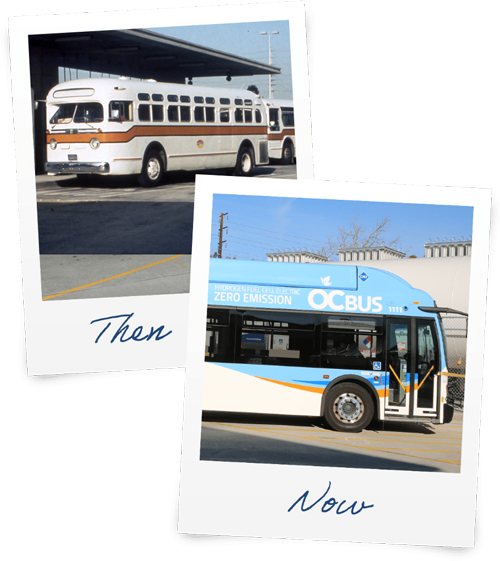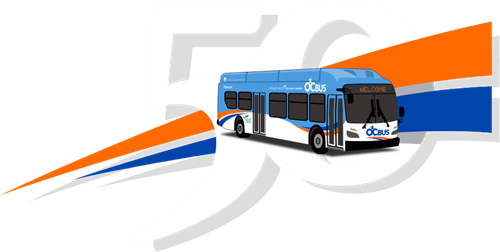Take a journey thru our history
Since 1972, we've evolved and grown into a thriving and sophisticated transit system, one of the nation’s finest.


Milestones
We've come quite a way in 50 years. The journey continues.
1972
Bus Service Begins
Bus service begins with the formation of the Orange County Transit District (OCTD) and consists of five leased buses and three routes serving 25,000 passengers a month. The 25-cent flat fare for local buses with free transfers remains unchanged for six years.
1973
Launch of Dial-A-Ride
First Dial-A-Ride service west of the Mississippi begins. This on-demand service in local communities connects passengers to local and express routes.
1974
Fullerton Park-and-Ride opens
OCTD opens its first permanent Park-and-Ride facility in Fullerton to help provide direct bus service to downtown Los Angeles.
1976
First Maintenance and Operations Facility in Irvine
OCTD revamps an Irvine building into its first permanently owned maintenance and operations facility including a large maintenance building, fueling center, bus wash, interior cleaner and fare extraction system. By 1978, it would accommodate 153 buses and 227 staff autos.
1977
Garden Grove Bus Base Built
To support the growing demand for bus service in the heart of the county, OCTD builds the Garden Grove bus base, the largest OCTD facility to date with 13.6 acres, a complete maintenance facility and parking stalls for 254 buses and 446 cars.
1979
Gas Crises Fuels Dramatic Growth
Fueled by the gas crisis, daily ridership grows dramatically from 71,000 to more than 100,000. By mid-year, ridership surpasses 2.5 million. To accommodate demand, OCTD purchases 175 GMC advanced-design vehicles, the largest bus purchase in its history.
1980
Annual Ridership Hits 20 Million
Annual ridership grows dramatically to more than 20 million and the OCTD fleet keeps pace, expanding from five to nearly 500 large buses and more than 140 smaller buses with 53 local routes and 5,800 bus stops.
1984
Santa Ana Transit Terminal Opens
Santa Ana Transit Terminal opens offering bus connections and customer information.
1991
OCTD and 6 Agencies Join to Form OCTA
To improve transportation efficiencies in Orange County, OCTD joined six other transit agencies to form the Orange County Transportation Authority (OCTA). Agencies included the Congestion Management Agency, Consolidated Transportation Service Agency, Local Transportation Agency, Orange County Transportation Commission, Service Authority for Freeway Emergencies, Service Authority for Abandoned Vehicles.
1993
OCTA Access Begins Service
OCTA increases and enhances services for those with disabilities by launching ADA paratransit services under the name OCTA Access. OCTA transitions Dial-A-Ride and Dial-A-Lift service to OCTA Access.
1999
Measure M Helps Lower Fares
The Measure M-funded Fair Stabilization Program begins offering discounts for seniors and persons with disabilities. The flat-rate day passes offer unlimited rides on the day of purchase. OCTA implements the Point-to-Point system to reduce route duplication, adding 12 new routes and nearly 100,000 service hours.
2000
Hybrid Electric Bus Testing
With an eye toward the future and addressing low-emission vehicles, OCTA debuts the first full-sized hybrid electric bus, part of a test-site program from manufacturer New Flyer of America. This program is a giant step toward testing and investing in zero-emission technology. OCTA also adds 61 Liquified Natural Gas (LNG) buses with 60 percent lower emissions compared to diesel buses.
2002
Farebox Technology Implemented
New farebox technology installed on all 589 fixed route buses improves revenue counting and data collection, facilitates magnetic "swipe and ride" passes and allows the use of a new 30-day pass no longer tied to a single calendar month. OCTA also added 24-hour Night Owl service was added on 4 routes to meet late-night and early-morning travel demands.
2005
OCTA Receives Prestigious APTA Award
OCTA receives the Outstanding Public Transportation System Achievement Award from the American Public Transportation Association (APTA) thanks to record ridership growth for its bus and rail customers, fiscal and caring management for paratransit customers and a visionary executive team. In addition, OCTA opens its fourth and largest bus base in Santa Ana, a 20-acre state-of-the-art maintenance and operations facility used as a model by two Northern California transit agencies.
2006
OC Express Bus Service Begins
OCTA rolls out three OC Express service routes between OC and the Inland Empire that travel on HOV lanes and the 91 Express Lanes and stop only at major employment centers. This premium service includes reclining seats, power hookups and lap trays.
2013
Bravo Bus Service Debuts
Bravo bus service debuts to speed commutes by reducing the number of stops on longer routes, including Harbor Boulevard. The success of the first route, Bravo 543, paved the way for Bravo Route 529 and Bravo Route 560.
2016
Rebranding to OC Bus
OC Bus, the new name for bus service in Orange County, provides a friendlier and stronger connection to riders and the county. The new logo and a cheerful orange and blue wave design is later applied to OC Access, OC Flex, OC Streetcar and OC Go to create a family of services.
2020
Launch of Hydrogen Fuel Technology
At its Santa Ana Bus Base, OCTA unveils the largest transit-operated hydrogen fueling station in the nation and 10 new hydrogen fuel cell electric buses. In addition, 55 field supervisor support vehicles that run on compressed natural gas (CNG) are replaced with an equal number that produce zero emissions.
2022
Plug-in Electric Buses Begin Operation
Plug-in battery electric buses begin operating as part of a pilot program that also includes 10 previously deployed hydrogen fuel-cell electric buses. This new pilot will help determine which technology – or mix of technologies – will work best for Orange County moving forward as OCTA moves to convert the OC Bus fleet to 100% zero-emission technology by 2040.

